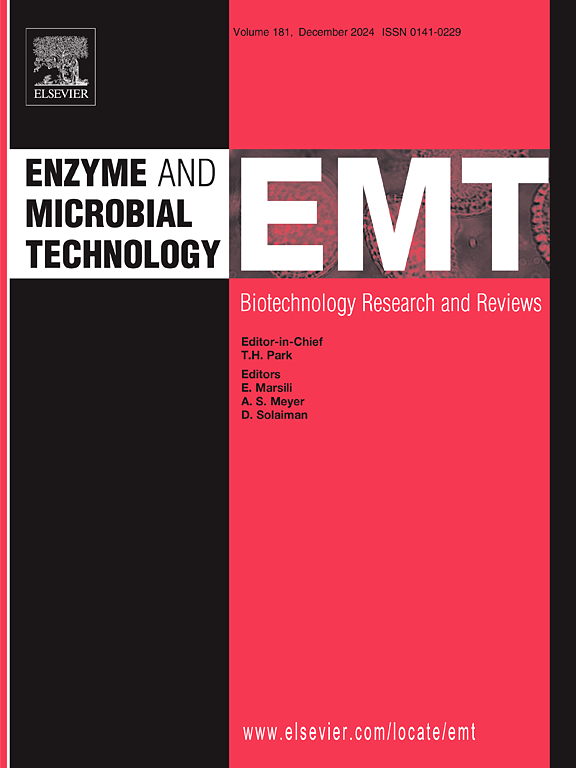Production of bio-indigo from engineered Pseudomonas putida KT2440 harboring tryptophanase and flavin-containing monooxygenase
IF 3.4
3区 生物学
Q2 BIOTECHNOLOGY & APPLIED MICROBIOLOGY
引用次数: 0
Abstract
Indigo is a unique blue dye that has been used in the textile industry for centuries and is currently mass-produced commercially through chemical synthesis. However, the use of toxic substrates and reducing agents for chemical synthesis is associated with environmental concerns, necessitating the development of eco-friendly alternatives based on microbial production. In this study, a robust industrial strategy for indigo production was developed using Pseudomonas putida KT2440 as the host strain, which is characterized by its excellent ability to degrade aromatic compounds and high resistance to environmental stress. By introducing the genes tryptophanase (tnaA) and Flavin-containing monooxygenase (FMO), a P. putida HI201 strain was constructed to produce indigo from tryptophan. To enhance the indigo yield, culture conditions, including medium composition, temperature, tryptophan concentration, and shaking speed, were optimized. Under optimal conditions such as TB medium, 15 mM tryptophan, 30°C, 200 rpm, P. putida HI201 biosynthesized 1.31 g/L indigo from tryptophan in a fed-batch fermentation system. The introduction of tnaA and FMO genes also enabled the production of indigo in various P. putida species, and the indigo-producing strain had a blue color, which served as a visual indicator. This study presents a strategy for using P. putida as a host for robust and sustainable microbial production of indigo, highlighting the strain's applicability and efficiency in environment friendly dye synthesis.
利用携带色氨酸酶和含黄素单氧化酶的工程假单胞菌 KT2440 生产生物靛蓝。
靛蓝是一种独特的蓝色染料,几个世纪以来一直用于纺织业,目前通过化学合成进行大规模商业化生产。然而,使用有毒底物和还原剂进行化学合成会引起环境问题,因此有必要开发基于微生物生产的生态友好型替代品。该菌株具有降解芳香族化合物能力强、抗环境胁迫能力强等特点。通过引入色氨酸酶(tnaA)和含黄素单氧化酶(FMO)基因,构建了一株利用色氨酸生产靛蓝的假单胞菌 HI201。为提高靛蓝产量,对培养基成分、温度、色氨酸浓度和振荡速度等培养条件进行了优化。在 TB 培养基、15 mM 色氨酸、30°C、200 rpm 等最佳条件下,P. putida HI201 在饲料批量发酵系统中从色氨酸中生物合成了 1.31 g/L 的靛蓝。引入 tnaA 和 FMO 基因也能在不同种类的 P. putida 中产生靛蓝,而且产生靛蓝的菌株呈蓝色,可作为视觉指标。本研究提出了一种以 P. putida 为宿主进行稳健、可持续的靛蓝微生物生产的策略,凸显了该菌株在环境友好型染料合成中的适用性和高效性。
本文章由计算机程序翻译,如有差异,请以英文原文为准。
求助全文
约1分钟内获得全文
求助全文
来源期刊

Enzyme and Microbial Technology
生物-生物工程与应用微生物
CiteScore
7.60
自引率
5.90%
发文量
142
审稿时长
38 days
期刊介绍:
Enzyme and Microbial Technology is an international, peer-reviewed journal publishing original research and reviews, of biotechnological significance and novelty, on basic and applied aspects of the science and technology of processes involving the use of enzymes, micro-organisms, animal cells and plant cells.
We especially encourage submissions on:
Biocatalysis and the use of Directed Evolution in Synthetic Biology and Biotechnology
Biotechnological Production of New Bioactive Molecules, Biomaterials, Biopharmaceuticals, and Biofuels
New Imaging Techniques and Biosensors, especially as applicable to Healthcare and Systems Biology
New Biotechnological Approaches in Genomics, Proteomics and Metabolomics
Metabolic Engineering, Biomolecular Engineering and Nanobiotechnology
Manuscripts which report isolation, purification, immobilization or utilization of organisms or enzymes which are already well-described in the literature are not suitable for publication in EMT, unless their primary purpose is to report significant new findings or approaches which are of broad biotechnological importance. Similarly, manuscripts which report optimization studies on well-established processes are inappropriate. EMT does not accept papers dealing with mathematical modeling unless they report significant, new experimental data.
 求助内容:
求助内容: 应助结果提醒方式:
应助结果提醒方式:


